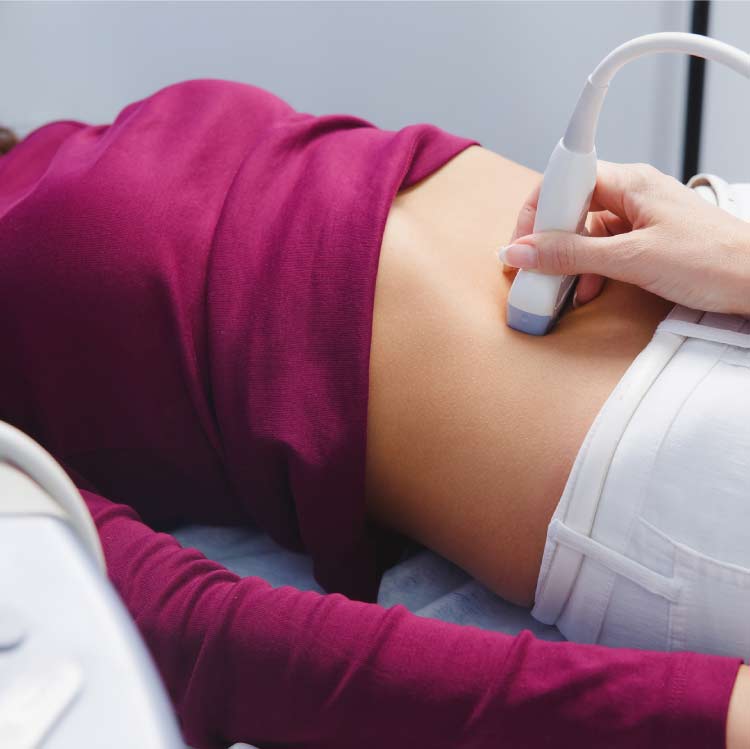Short-term treatment. Designed for long-term relief.
From low back and knee pain to persistent headaches, pain can keep you from fully participating in the life you want. It doesn’t have to stay that way.
Introducing the SPRINT Peripheral Nerve Stimulation (PNS) System

SPRINT PNS has been used to treat:
• Chronic back pain
• Chronic head & neck pain
• Non-operable joint pain
• Post-operative pain
• Post-amputation pain
• Pain due to nerve trauma


MICROLEAD
A thin, flexible threadlike wire, approximately twice the size of a human hair, placed under your skin near a nerve that is causing pain delivers the stimulation treatment.

PULSE GENERATOR
A matchbox-sized, battery-powered wearable stimulator sends gentle electrical pulses through the MicroLead to your nerve.

HAND-HELD REMOTE
A small wireless controller allows you to turn the stimulation on and off and to adjust its intensity.
How does SPRINT PNS work?
During the 60-day treatment period, the SPRINT PNS System sends tiny electrical pulses through the MicroLead placed near the target nerve.
This stimulation is believed to interrupt the pain signals, boost the healthy non-pain signals, and help rebalance the information the brain receives.
Over time, stimulation of a peripheral nerve with SPRINT PNS is believed to actually change how your brain may perceive and respond to pain.
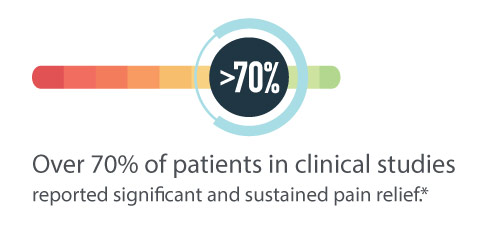
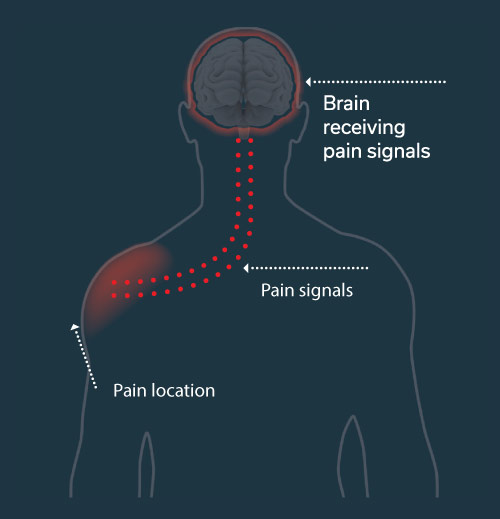
Before treatment
Pain is felt when a nerve sends pain signals to your brain.

During treatment
Tiny electrical pulses are sent through the MicroLead. These pulses are believed to help rebalance the types of signals your nerve(s) send to your brain — replacing pain signals with non-pain signals. These pulses are sometimes felt as comfortable, nonpainful sensations, such as mild tingling, pulsing, vibration, or pressure, in or around the area of pain.
Following treatment
Following the 60-day treatment with SPRINT PNS, it is believed that the brain no longer responds to pain signals in the same way. SPRINT PNS is believed to interrupt the pain signals, boost the healthy non-pain signals, and help rebalance the information the
brain receives.
*For complete references, please refer to SprintPNS.com.
*Images above depict treatment for shoulder pain and are for example purposes only.
Sample Placements of SPRINT PNS
Your physician will determine if a system with one or two leads is best for your situation and will also determine the appropriate placement of the device for your treatment.
Depending on the location, you may need help changing the bandage regularly during the 60-day treatment.

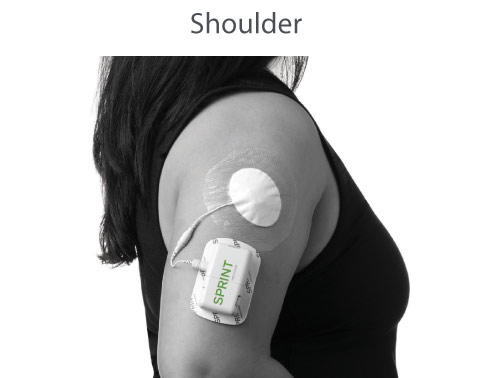
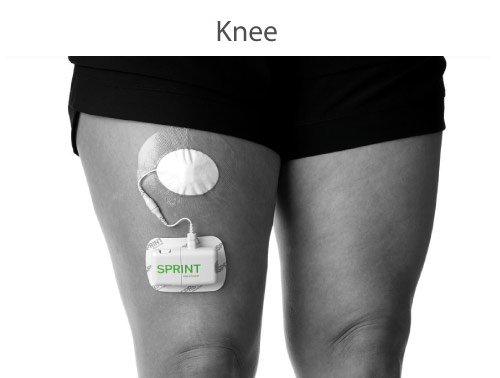

*Actual placement of the SPRINT PNS System on your body may vary. Images are for example purposes only.
What to expect with SPRINT PNS

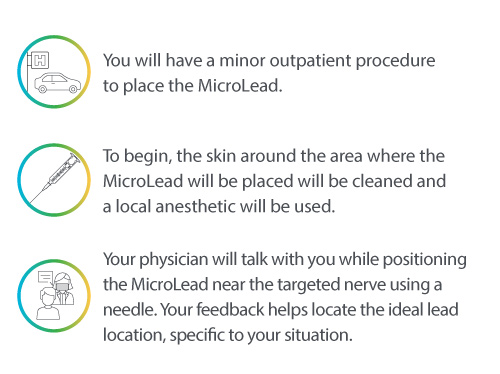
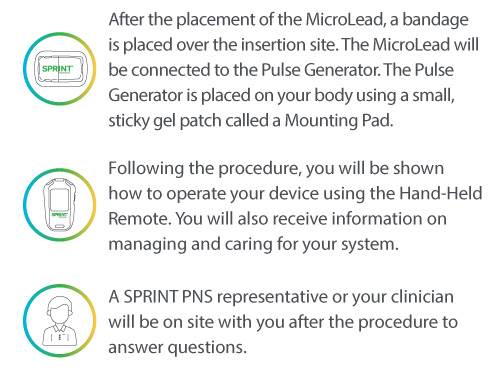
That’s it! Your treatment has now started. You may experience relief right away or notice that relief may develop over several weeks.

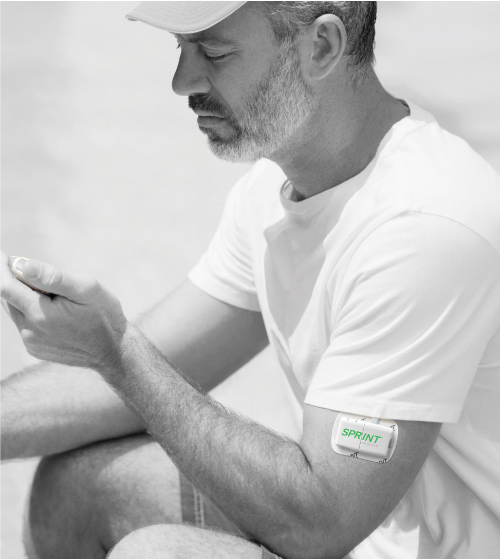
Frequently Asked Questions
How often should I change my bandage?
Your physician or a SPRINT representative will spend time with you discussing how to clean and care for the treatment area, including the lead insertion site. The bandage will typically need to be changed 1-2 times each week. If the bandage becomes soiled, damp or starts to peel, the bandage should be changed.
Are there any activity limitations?
You will need to limit activity and motion near the treatment area for 1 week following the procedure. Following the initial 7-day period, you will be able to resume most normal activities while using SPRINT PNS. Your physician will provide guidance based on your individual treatment and needs.
Will SPRINT PNS work for me?
While results vary, over 70% of patients in clinical studies reported clinically significant pain relief.
When will I experience pain relief?
Some patients see an improvement in their pain right away. Some patients find that pain relief takes time and gradually develops over the course of several weeks.
How long will my pain relief last?
While every patient is different and results vary, research studies found that most patients had sustained pain relief for months or more after treatment ends. Some studies followed patients for a year and a majority of patients continued to have sustained relief after treatment ends. One survey of patients found that a majority of those who responded to the treatment had sustained long-term improvements in pain and/or quality of life, including
some patients 24+ months post-treatment.
What risks or side effects are associated with SPRINT PNS?
The most common adverse event reported in clinical studies was skin irritation due to components being adhered to the skin (which may include inflammation, mild blistering, and/or redness). Other less-reported events included itching at the lead exit site, pain after lead placement and infection. The majority of the adverse events in clinical studies were resolved with little to no intervention within a few days, and none were classified as serious. Similar adverse events have been reported outside of clinical studies. Infections have been reported for 1-2% of patients. Serious adverse events have been rare.
It is possible that a piece of the MicroLead may remain beneath your skin following the treatment. If this happens, your physician will discuss with you whether the piece should be removed. Surgical removal of a piece of the MicroLead is rarely advised, as most instances pose little to no risk.
Is SPRINT PNS covered by insurance?
Many insurance companies cover SPRINT PNS. SPRcare™, a Patient Access Program for the SPRINT PNS System, can provide support to you and your physician’s staff in attempt to obtain coverage from your insurance company.
Can I get an MRI while using SPRINT PNS?
Magnetic Resonance Imaging (MRI) is not allowed on any part of the body while you are using the SPRINT PNS System. Exposure can cause tissue heating and injury or unwanted
stimulation. If your physician determines that an MRI is necessary during the treatment period, the MicroLead and all other system components must be removed before the MRI. If a piece of the MicroLead remains beneath your skin after removal, it’s safe to receive an MRI under certain conditions that will be provided to you and your healthcare provider.
